Planetary Field Analogues: KamchatkaProvided by: Space Research Institute of Russian Academy of Sciences (IKI-RAS) Homepage:Please note that this facility will not be open until Summer 2010. Applications can still be submitted, but visits can not take place until 2010. |
 |
Scientific Contact:Doctor Oleg Korablev Expert:Professor Alexander BazilevskiyLaboratory of Comparative Planetology Institute of geochemistry and analytical chemistry, Kosygin Street 19, 119991, Moscow, Russia Email: Phone +7 495 137 49 95 |
Local administrative contact (once a TNA visit is awarded):Ms Nadya Evdokimova, Space Research Institute of Russian Academy of SciencesPhone +7 495 333 40 67 Fax +7 495 333 21 02 |
Some details about expeditions to Kamchatka, Mutnovsky-Gorely volcanoes:
- The number of external participants: 2 persons
- The expedition duration: approximately 2 weeks
- The assumed period for expedition: from August 15 to September 15, 2010, due to the favourable weather conditions in this season.
- The participants have to organize their travel to Petropaclovsk-Kamchatsky themselves. The recommended itinerary to Kamchatka is via Moscow, i.e. point of your location in Europe/Moscow/ Petropavlovsk-Kamchatsky. The cost of return ticket (Moscow / Petropavlovsk-Kamchatsky /Moscow) varies from 500 to 1500 Euros and depends on booking time. Usually cheaper rates are available until beginning of May. Europlanet covers travel expenses within 2500 Euros per person. These expenses are to be refunded directly by Europlanet office.
- The duration of flights from Moscow to Petropavlovsk-Kamchatsky is about 9 hours.
- The transportation from Petropavlovsk-Kamchatsky to the Mutnovsky-Gorely site is organized by IKI by means of heavy cross-country track. On site foodstuff, fuel, telecommunication equipment , electricity (220V), shelters and other necessary equipment will be available.
Facility Description
|
Kamchatka is a peninsula in the Russian Far East that is a volcanically active region characterised by intense and varied hydrothermal activity. We can submit for consideration
|
Mytnovsky volcano
|
Mutnovsky volcano (Fig. 1) is located 75 km from the city of Petropavlovsk-Kamchatsky and 20 km from the coast of Pacific Ocean, beyond the chain of Coast ridge (Kirsanov et al., 1991; Selyanin, 1993). The observations of the Mutnovsky volcano is carring out for a time period more than 15 years. Also we use this observations for the validation of the geochemical methods for eruption prediction. It was find here a great number of fomarola (vapour-gaseous) outcrops. Besides it was find a lot of separate differ and permanently migrated thermal sources (with various debit) which outfalls into the Vulcannaya river. (This river accumulates almost all solute and non-solute mineral material of the volcanic thermal water). By monitoring of the variations in the river water content it is possible to conclude about the total (integral) consistent of the everythig thermal sources near the volcano taken together. In other word, the regular monitoring of the Vulcannaya river water can be used in the volcano Mutnovsky activity forecasts. Unfortunately we have approved only the short-term forecasts. This method is a regime hydrochemical annual sampling of river water from the two different cross sections: topper one (in the southern part of the northeastern crater) and lower one (three kilometers down the stream, at the western slope of the volcano). Analyzing this sampling it is possible to identify all dissolved macro-components such as SO4–2, Cl–, and F– anions. From hydrochemical data gathered during 16 years of monitoring it is evident that the sulphur-haloid ions ratios didn’t vary very appreciably during the period 1992-1997. After 1997 this ratios began to increase. Maximum value of SO4–2/F– ratio for the upper cross section was reached in 1998, and maximum value of SO4–2/Cl– - in 1999. These maxima was registered with the time interval ~1 year, and the spacing of the regime observations also was ~1 year. The contrary results was obtained for corresponding ratios at the lower cross section of the river: maximum for SO4–2/F– ratio was in 1999 and SO4–2/Cl– - in 1998. The strong eruption of Mutnovsky occurred in a six months after these maxima, and after this the ratios of main anions in the water of Vulkannaya river decreased (Gavrilenko et al., 2007). At the end of 2001 and 2002 these ratios became to increase again. And a half of year later the repeated enhancement of activity in the southwester crater took place. As early as 2003 the crateral lake was covered by ice and snow. Few days later ice and snow melted and the temperature of water increased to 35°C. Simultaneously the active convection of crateral water was observed (most probably due to fumarole-hydrothermal activity). After the active phase the passive phase began. All hydrochemical parameters monitored decreased to the minimal value in 2003. However the volcano didn’t come to rest. The hydrochemical parameters became to increase in 2004. This trend continued in 2005-2006. In april 2007 the high level of the continuous vibrations was detected by the radiotelemetrical network of the Department of the Geophysical service of RAS (Kamchatka). These values exceeded the background signal level in a few times. Our analysis of these and satellite data and the results of our field researches showed that the eruption really occured in 2007. And this eruption was “dry” mainly due to the gaseous magmatic masses. In consequence of the eruption the explosive crater was formed. The study of ash demonstrate the small-fraction material with the particle size less than 0.1 mm. This is mostly the fractured pyroxene andezite with a small admixture of pumice stone. The sizes of the rubbles of the altered rocks was less than 10% of total mass of ash. The volcanic events at Mutnovsky volcano occurred after 40 years of non-active period of the fomarole-hydrothermal activity. The constantly increasing in the volcanic vibration in the Mutnovsky region is still detecting by seismic station (Fig 2). |
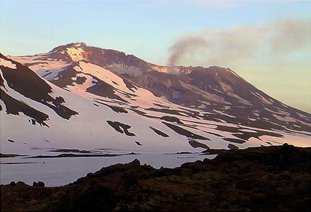 Figure 1 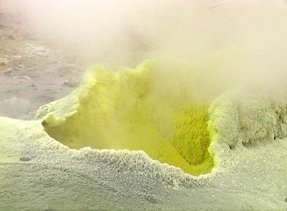 Figure 2 |
Gorely volcano
|
Gorely is the other active volcano in Southern Kamchatka which is closest to Mutnovsky volcano (Kirsanov et al., 1991; Selyanin and Ponomareva, 1999). Distance between them is 15 km (Fig.3). Active volcanic ridge Gorely is the part of the East volcanic belt of Kamchatka peninsula. With an apparent likeness of their ridged shapes and types of activity in historical time (phreato-magmatic and volcanic eruptions) these volcanoes differ considerably in prehistory and general mode of development. Structure of Gorely volcano is a linear volcanic ridge of 3 km in length along the crest which stretches in sublatitudinal west-north-western direction. It consists of three main cones acted for a long time and more than three tens of cones of one-act breakthroughs. The whole structure is located in extensive tectovolcanic basin – caldera having oval extended to the north-west shape and dimensions according to the axes 9x13 km. In contrast to Mutnovsky volcano Gorely volcano, thus, continues development of the more ancient volcanic centre. It is also notable for considerably lower height (maximum mark – 1829 m), volume of the structure (~ 25 km3), index of explosiveness (20-30%)and, correspondingly, steepness of flanks and heightened lava fluidity. According to these features strato-volcano Gorely can be referred to scutiform, i.e. transitional by the type to gently sloping shield, substantially lava constructions. To counterbalance to exclusevely explosive latest activity of Mutnovsky volcano which had formed practically completely by the time of 7-8 thou. years ago, Gorely volcano developed actively and grew up to the present time alternating explosions with outflows of numerous and various lava flows. Gorely volcano is referred to the volcanoes with features of Hawaii and Iceland types where equally with the most usual flows of block-lava there are also flows of little viscous lavas as pahoehoe, with sections of typical for them surfaces of ropy, pahoehoe, corded lava, with lava pipes, hornitoes (secondary microvolcanoes on flows), warpings and whimsical hummocks-kekurs. The latest eruptions occurred in the first half of 1980s. After this phase, the last phase of activity the acid thermal lake appeared in the central active crater of Gorely volcano. The lake has been existing since that time (Fig. 4, 5). It is well-known that crateral lakes existed in the different periods of time in the past. For example, they existed in 1960,1978, 1979, 1980, 1984. Last time the thermal lake originated in the active crater of Gorely volcano after eruption in 1985-1986. The water of this lake similar to the water of another crateral lakes in the world: temperature of it’s water ~40ºC, acidity (pH) ~1, mineralization >20 g/l. The color of the water is typical for all acid lakes and it is blue/green. During the period 1993-2008 visual observation to sub-aerial and sub-aqeous activity showed that lake activity is increasing annually, and the level of lake is increasing. The square of the lake enlarged more than 10 times for the period of the observations. During the period of 2000-2007 the area of the lake increased from 14000 m2 (2000) to 40000 m2 (2007). A significant jump in increasing of lake area was fixed during 2005-2007. The analysis of the thermal flux from the surface of the lake (ASTER data, daytime and night-time images) showed no changes during the period of the observations. It might be caused by thermal flux increasing from the interior of the lake. Obviously the activity in the central crater of Gorely volcano is constantly growing. Apart from the sub-aerial fumarole outcrops wich were along the border of the lake and on the internal side of the crater including the lake we observed stationary spots of diameter ~15-25 m in central part of the lake in July 2007. Evidently these spots are the traces of the upward gas-hydrothermal jets (spring). These spots were outlined by bright-yellow contour of the flotation colloid sulphur. The similar situation was observed in the crateral lake of Maly Semyachik volcano during the activation period in 1986. The repeated observation of the lake on Gorely was performed in January 2008. The activity of the lake was estimated. It is turned out that the content of gases flowing out from crater changed: apart from the haloid high-temperature gases sulfureous ones appeared. Similar observations were carried out in June of the that year. The situation on the lake and inside crater didn’t change. In a month in the end of July 2008 we managed take a water sample from the lake and measure its temperature (the last such measurement was performed in 2001 due to risky path to the lake). The temperature of the water was 42-44ºC at the moment of the last measurements. Detailed investigation revealed more intensive water movement on its surface, and the powerful spring was detected in the south-west part of the lake. It is very important to notice that a small-scale continious vibrations were observed in the volcano region for a period of time of more than half a year. Therefore we can conclude that a volcanic eruption will occure in the nearest future. So,the main evidences of this conclusion are: the fast increasing of the acid thermal lake level in the active crater ( ~3 m/y); increase of sub-aerial and sub-aqual activity (which observed on the total area on the inner slopes of the central active crater of volcano); the appearance of the haloid gases besides sulphuric ones;.a small-scale continious vibrations. |
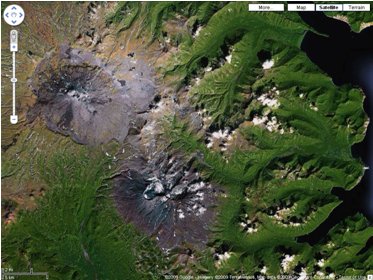 Figure 3 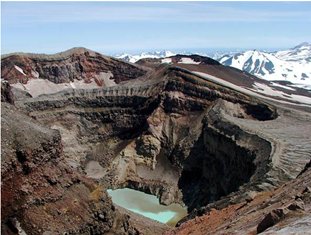 Figure 4 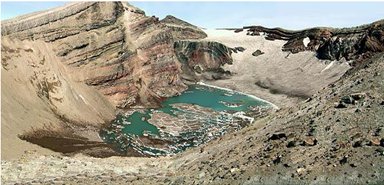 Figure 5 |
References
Selected relevant publications
2000—2006 hydrochemical monitoring data obtained from the active crater of Mutnovsky Volcano, Kamchatka, after the 2000 eruption
Gavrilenko G.M., Bortnikova S.B. Proceedings of the 12th Intern. Symp. on Water-Rock Interaction, 13—18 August. Chine. (2007) P.105—109.
Gorely volcano
Kirsanov I.T., Melekestsev I.V. Active volcanoes in Kamchatka. Moscow.: Nauka (1991) Pp. 292-315.
New about Mutnovsky volcano: structure, development, forecast
Selyangin O.B. Volcanology and seismology (1993) N 1. Pp. 17-35.
Structure and development of Gorelovsky volcanic centre, Southern Kamchatka.
Selyangin O.B., Ponomareva V.V. Volcanology and seismology (1999) N 2. Pp. 3-23.
For information on the Europlanet TNA programme contact:
Professor N J Mason, Department of Physics and Astronomy, The Open University, Walton Hall. Milton Keynes, MK7 6AA
Email (preferred method of contact)


